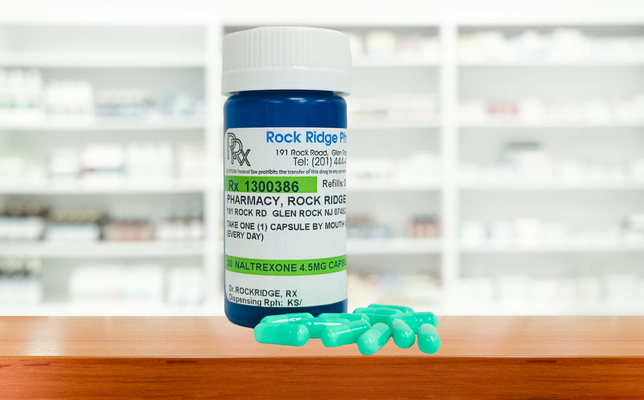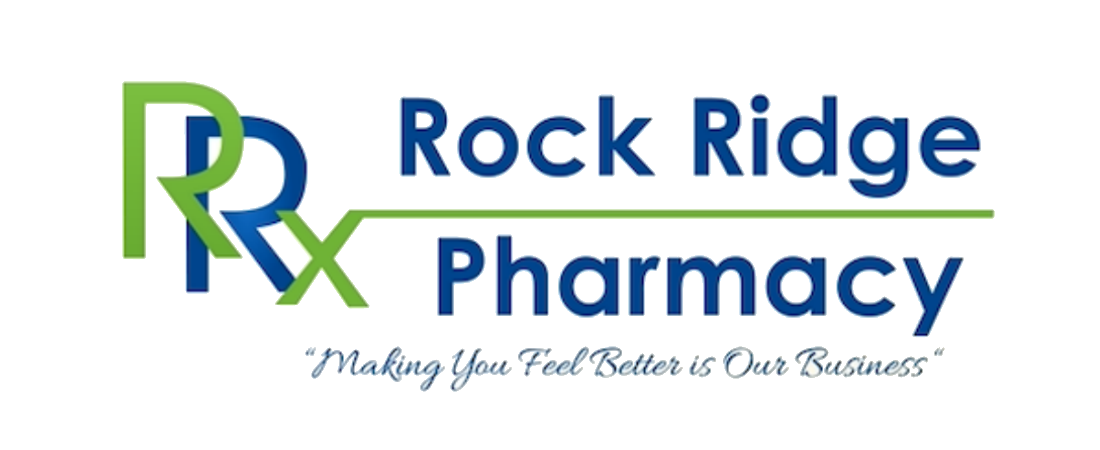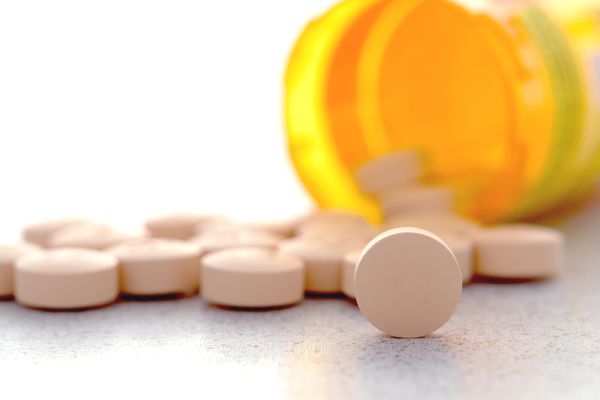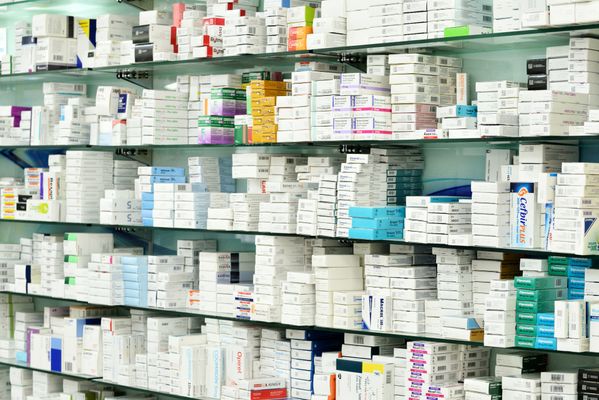LDN (Low Dose Naltrexone)
Rock Ridge Pharmacy : Compounding Experts for your Path to Better Health
Mechanism of Action:
Endorphin Release: LDN increases the secretion of endorphins, which are responsible for pain relief and inducing feelings of well-being.
Opioid Growth Factor (OGF): LDN increases the release of OGF, which helps reduce inflammation, autoimmune responses, and tumor cell growth.
Immune Modulation: LDN reduces inflammatory immune cell signaling, particularly via Toll-like Receptor-4, which can help alleviate autoimmune and inflammatory conditions.
Glial Cell Regulation: LDN calms glial cells in the nervous system, reducing inflammation of nerves and promoting nerve protection.
Dopamine Increase: LDN increases dopamine levels, which can enhance mood, energy, and cognitive function.
Why is LDN only available as a compounded medication?
Low Dose Naltrexone (LDN) is typically available only as a compounded medication because naltrexone, the active ingredient, is commercially manufactured in higher doses, typically as 50 mg tablets. However, LDN therapy requires much lower doses, usually ranging from 0.5 mg to 4.5 mg per day.
Here are the reasons why LDN is compounded:
Dose Customization: LDN therapy often involves doses significantly lower than the commercially available naltrexone tablets. Rock Ridge Pharmacy customizes the dosage precisely to meet the specific needs of each patient, ensuring accurate dosing for optimal therapeutic effects.
Formulation Flexibility: Rock Ridge Pharmacy offers various dosage forms, such as capsules, flavored oral suspensions, or transdermal creams, to accommodate individual preferences and requirements. This flexibility allows patients to receive LDN in a formulation that is most suitable for them, improving medication adherence and comfort.
- Quality Assurance: Rock Ridge pharmacy sources naltrexone powder from FDA-approved facilities to ensure the highest quality and purity of the active ingredient. By adhering to strict quality control standards, compounding labs can guarantee the safety and efficacy of compounded LDN formulations.
Conditions LDN May Benefit:
Chronic pain
Autoimmune disorders such as Hashimoto’s, Graves’ disease, ulcerative colitis, Crohn’s disease, psoriasis, and lupus
Neurological disorders such as Parkinson’s disease, multiple sclerosis, fibromyalgia, and restless leg syndrome (RLS)
Dermatological conditions like eczema
Gastrointestinal disorders including irritable bowel syndrome (IBS) and celiac disease
Polycystic ovary syndrome (PCOS)
Cancer (though more research is needed)
Inflammation in general

Dosing:
LDN therapy typically starts at low doses, around 0.5 mg to 1 mg, and is titrated up based on individual response and sensitivity to medication.
Traditional dosing involves starting at 1.5 mg at bedtime for one week, then increasing to 3 mg for another week, and finally settling at 4.5 mg at bedtime thereafter. However, dosing protocols may vary based on individual response.

Side Effects:
Side effects of LDN are generally minimal and may include vivid dreams, headaches, gastrointestinal upset, and increased sensitivity to thyroid medications.
Most side effects are mild and transient, often resolving within the first few days of therapy or with dose adjustments.
Response Time:
Response time to LDN therapy varies widely among individuals and medical conditions.
Some patients may experience significant improvement within the first two months, but experts suggest that maximum benefits may require up to eight months of therapy.
Narcotics & Low Dose Naltrexone (LDN)
It's important to understand that narcotic pain relievers, also known as opioids, should not be used concurrently with Low Dose Naltrexone (LDN). LDN works by blocking opioid receptors in the brain, which can negate the effects of opioids and potentially lead to withdrawal symptoms if opioids are taken while on LDN therapy.
Here are key points regarding the use of opioids and LDN:
Blocking Effect: LDN blocks opioid receptors, which are the same receptors targeted by narcotic pain relievers. This means that if a patient takes opioids while on LDN therapy, the opioid medications will have reduced or no effect, leading to inadequate pain relief.
Potential for Withdrawal: If a patient has developed any degree of dependence on opioids, taking LDN can precipitate withdrawal symptoms due to the blocking effect on opioid receptors. These withdrawal symptoms can range from uncomfortable to severe and may require medical intervention.
Clinical Considerations: Before initiating LDN therapy, healthcare providers should carefully assess the patient's opioid use history and consider the potential risks and benefits. In cases where patients are already using opioids, a gradual tapering of opioid medications may be necessary before starting LDN to avoid withdrawal symptoms.
- Collaboration with Pain Management Specialists: In cases where patients are on long-term opioid therapy for chronic pain, collaboration with pain management specialists can be beneficial. Pain management specialists can help devise a safe and effective tapering plan for opioids while initiating LDN therapy to minimize withdrawal symptoms and optimize pain management.
Titration of Low Dose Naltrexone (LDN):
Indeed, titrating the dose of Low Dose Naltrexone (LDN) is crucial for achieving success in treatment. LDN is typically administered once daily, and finding the optimal dose for each individual patient requires a balance of both scientific understanding and clinical judgment. Here's why titration is important and how it's typically approached:
Individualized Treatment: Every patient responds differently to LDN, and there is no one-size-fits-all dose. Thus, titration allows healthcare providers to tailor the dosage to each patient's specific needs, taking into account factors such as the severity of the condition being treated, individual sensitivity to medication, and tolerance of side effects.
Start Low, Go Slow: The principle of "start low, go slow" is often applied when initiating LDN therapy. This involves beginning with a low dose, such as 0.5 mg, and gradually increasing the dosage over time while closely monitoring the patient's response. This approach helps minimize the risk of side effects and allows the patient's body to adjust to the medication gradually.
Aiming for the Sweet Spot: While 4.5 mg is often considered a common target dose for LDN, it's important to recognize that this is not a rigid endpoint. Instead, it serves as a reference point or "sweet spot" where many patients may experience optimal therapeutic effects. However, some patients may require higher or lower doses to achieve the desired outcome, underscoring the importance of individualized titration.
- Monitoring and Adjusting: Throughout the titration process, healthcare providers closely monitor the patient for both therapeutic effects and any adverse reactions. Adjustments to the dosage may be made based on the patient's response, with the goal of maximizing benefits while minimizing side effects.

Pharmacist's Role:
Pharmacists play a crucial role in LDN therapy by providing dosing consultation to prescribers, counseling patients on medication use, assisting with titration schedules, and serving as a resource for information and support throughout the treatment process.
Ways to Send In Prescriptions:
1. Fax
Write a prescription on a prescription pad and fax over to 201-444-2698.
2. E-Scribe
E-Rx (E-scribe) to “Rock Ridge Pharmacy”
Make sure our address is 191 Rock Rd, Glen Rock, NJ 07452.
3. Call
Call in your prescription to 201-444-4190.
4. Fill Out Pre-made Rx Order Forms from Rock Ridge Pharmacy
Fill out Rock Ridge Pharmacy Rx Order Forms and Fax »
Access to these Rx Forms is exclusively for physicians. Click here to request access.
5. Telemedicine
Rock Ridge Pharmacy, in partnership with Physician 360, offers on-demand telemedicine consultations for LDN and other conditions. Learn more below.
How To Start:
Follow the steps below to get started and to sign up for a consultation!
- Click Start Now (Green Button Above)
- Create an account and log in at visit.physician360.co [start now button above]. Take a brief questionnaire about your symptoms or reason you would like to speak to a provider.
- Within approximately 5-10 minutes, connect with a medical professional on your phone or your computer [if an RX is warranted, the RX will be sent to Rock Ridge Pharmacy right after the call]
- If needed, a prescription will be electronically sent to our team at Rock Ridge Pharmacy.
Rock Ridge Pharmacy is located at 191 Rock Rd, Glen Rock NJ, 07452
We are dedicated to offering specialized Low Dose Naltrexone (LDN) services tailored to your individual needs. Our team of knowledgeable pharmacists is committed to providing comprehensive support and guidance throughout your LDN journey. Whether you're seeking LDN for its therapeutic benefits in managing various conditions or exploring its potential off-label uses, we are here to assist you every step of the way.
FAQ For LDN
What is Low Dose Naltrexone (LDN)? ➤
LDN is a medication originally designed to treat opioid addiction at higher doses. At low doses, typically between 0.5 mg to 4.5 mg, it is used for its immunomodulatory and anti-inflammatory properties, particularly in autoimmune disorders, chronic pain management, and some neurological conditions.
How does LDN work? ➤
LDN works by modulating the immune system and reducing inflammation through the temporary blockage of opioid receptors, which increases the production of endorphins and enkephalins—natural painkillers and mood enhancers.
Who might benefit from LDN? ➤
Patients with various conditions including multiple sclerosis, rheumatoid arthritis, fibromyalgia, chronic pain, and certain mental health issues like depression may benefit from LDN.
How is LDN dosed and administered? ➤
Treatment starts with a low dose, often 0.5 mg, gradually increasing to a typical maximum of 4.5 mg daily, based on individual response and tolerance. LDN is available in various forms like capsules, oral solutions, or topical creams, customized by compounding pharmacies.
What are common side effects? ➤
Side effects may include vivid dreams, insomnia, headaches, and gastrointestinal issues, but they are generally mild and temporary. Monitoring and communication with a healthcare provider are essential for managing any adverse effects.
What should patients expect in terms of treatment response? ➤
The response varies significantly among individuals. Some may notice improvements within a few weeks, while others might need up to six months to evaluate the full benefits of LDN.
Can LDN be used with opioid medications? ➤
LDN should not be used concurrently with opioid pain relievers due to its opioid-blocking effects, which can lead to withdrawal symptoms and ineffective pain management.
What considerations should be made before starting LDN? ➤
Patients should discuss their full medical history, including any other medications, with their healthcare provider. It's important to consider potential interactions and the patient’s specific health conditions.
How do healthcare providers monitor LDN treatment? ➤
Providers typically monitor treatment through regular follow-ups, assessing symptom relief and side effects. In some cases, blood tests may be conducted to monitor specific health markers.
What research supports the use of LDN? ➤
While growing interest and anecdotal evidence suggest benefits, more extensive clinical trials are needed to fully establish LDN’s efficacy across various conditions.






